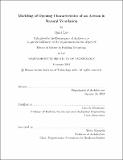| dc.contributor.advisor | Leon R. Glicksman. | en_US |
| dc.contributor.author | Luo, Qinzi | en_US |
| dc.contributor.other | Massachusetts Institute of Technology. Department of Architecture. | en_US |
| dc.date.accessioned | 2018-05-23T15:05:27Z | |
| dc.date.available | 2018-05-23T15:05:27Z | |
| dc.date.copyright | 2018 | en_US |
| dc.date.issued | 2018 | en_US |
| dc.identifier.uri | http://hdl.handle.net/1721.1/115629 | |
| dc.description | Thesis: S.M. in Building Technology, Massachusetts Institute of Technology, Department of Architecture, 2018. | en_US |
| dc.description | This electronic version was submitted by the student author. The certified thesis is available in the Institute Archives and Special Collections. | en_US |
| dc.description | Cataloged from student-submitted PDF version of thesis. | en_US |
| dc.description | Includes bibliographical references (pages 97-99). | en_US |
| dc.description.abstract | Atriums are widely applied in non-residential buildings to provide social contact, daylight, air circulation, and aesthetic requirements. Buoyancy-driven ventilation systems are common because they can maintain suitable thermal comfort and reduce energy. Modeling techniques used to simulate naturally ventilation include analytical models, full-scale and small-scale experiments, computational fluid dynamics(CFD) and airflow network tools, which have advantages and limitations. Investigations on atrium structure and opening characteristics have been limited up to now. This thesis studies the temperature stratification and air flow rates inside atrium buildings in purely buoyancy-driven ventilation. Ventilation effects in models with different heat sources, opening locations, opening sizes and numbers of floors are compared using CFD simulations. An airflow network tool, CoolVent, is used to compare the results with CFD models. Both temperatures and flow rates match well with discrepancies less than 10%. Therefore, the well-mixed temperature assumption in the atrium in the airflow network tool is suitable for single-layer atrium buildings. The full-scale experiment provides a detailed data set for further investigations. Air temperatures keep stable on every floor but increase with height. Therefore, the well-mixed temperature assumption over the entire height of the atrium in many analytical models is not applicable when the cross section of the atrium is small. The prediction of temperature distribution and flow rates in atrium buildings with buoyancy-driven ventilation is provided in details. Indoor air temperatures and flow rates can be calculated with known outside air temperatures and surface temperatures in the atrium. The estimation of heat transfer coefficients, especially the approximation of stairs can cause some discrepancies between calculated and actual results. | en_US |
| dc.description.statementofresponsibility | by Qinzi Luo. | en_US |
| dc.format.extent | 99 pages | en_US |
| dc.language.iso | eng | en_US |
| dc.publisher | Massachusetts Institute of Technology | en_US |
| dc.rights | MIT theses are protected by copyright. They may be viewed, downloaded, or printed from this source but further reproduction or distribution in any format is prohibited without written permission. | en_US |
| dc.rights.uri | http://dspace.mit.edu/handle/1721.1/7582 | en_US |
| dc.subject | Architecture. | en_US |
| dc.title | Modeling of opening characteristics of an atrium in natural ventilation | en_US |
| dc.type | Thesis | en_US |
| dc.description.degree | S.M. in Building Technology | en_US |
| dc.contributor.department | Massachusetts Institute of Technology. Department of Architecture | |
| dc.identifier.oclc | 1036987206 | en_US |
